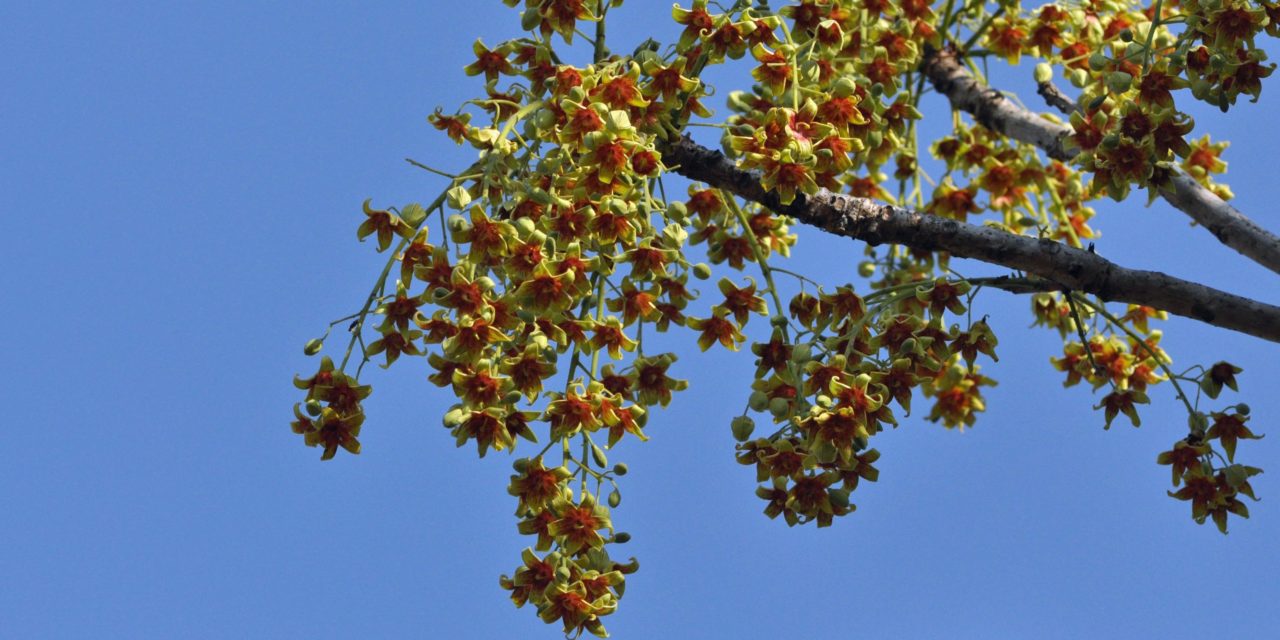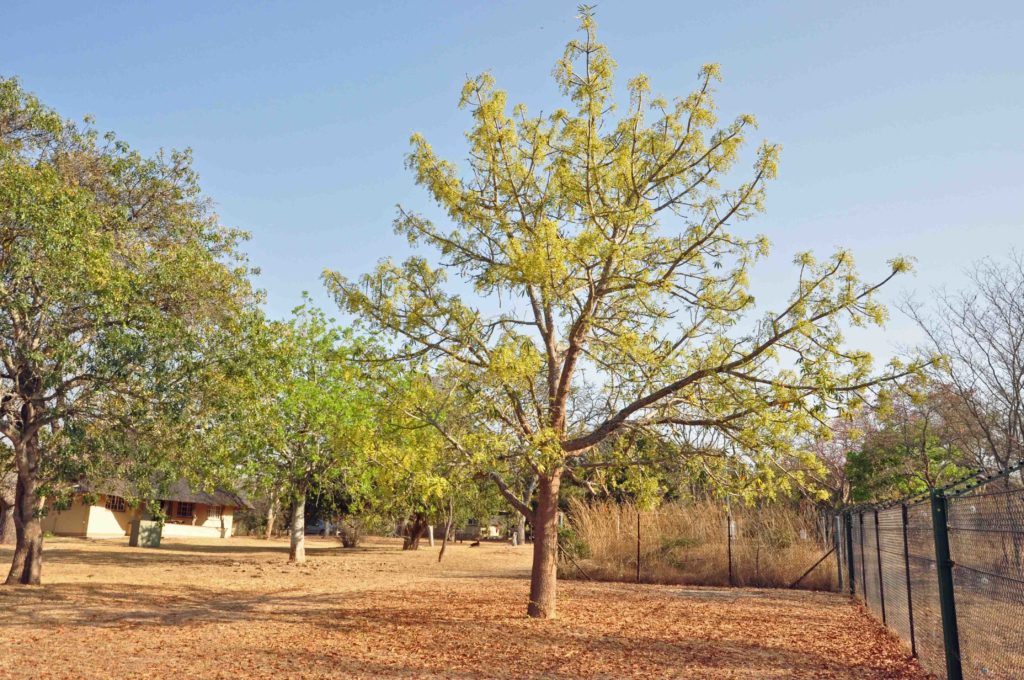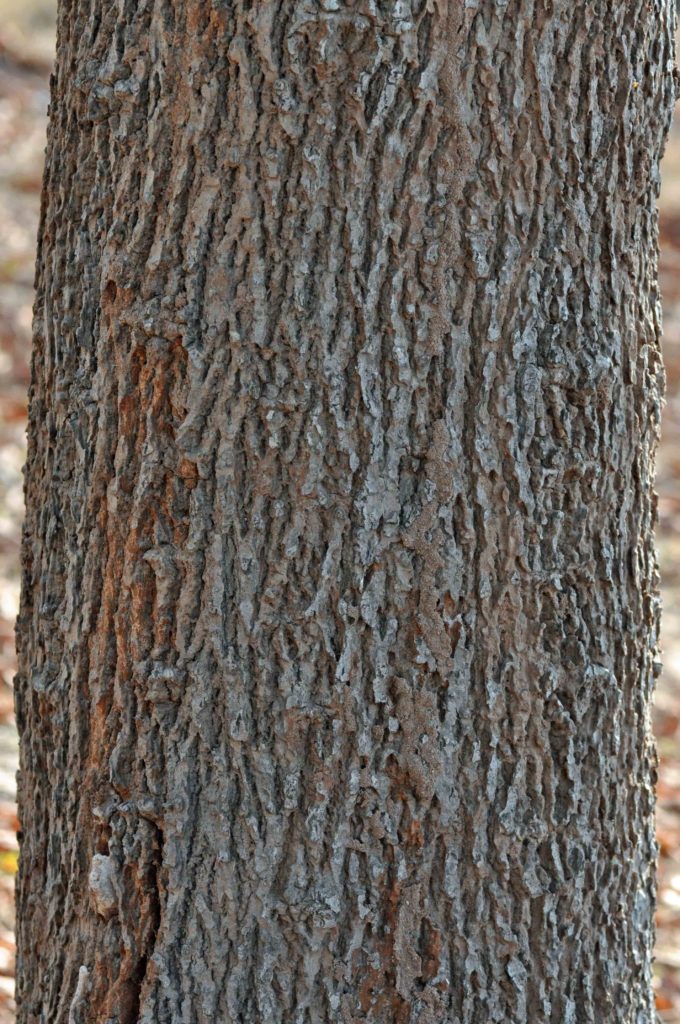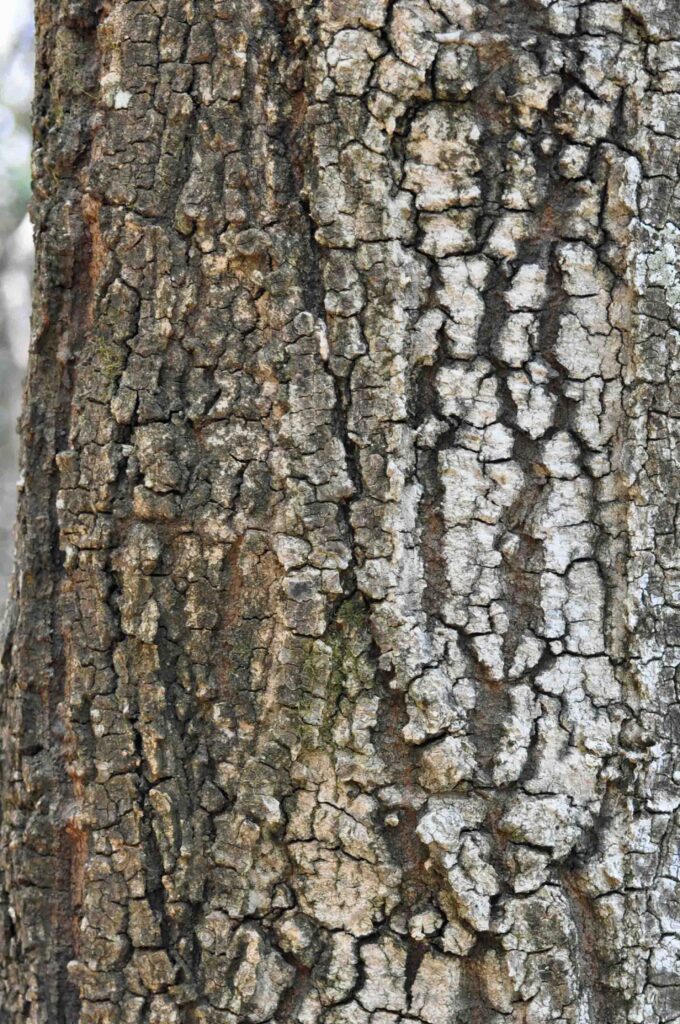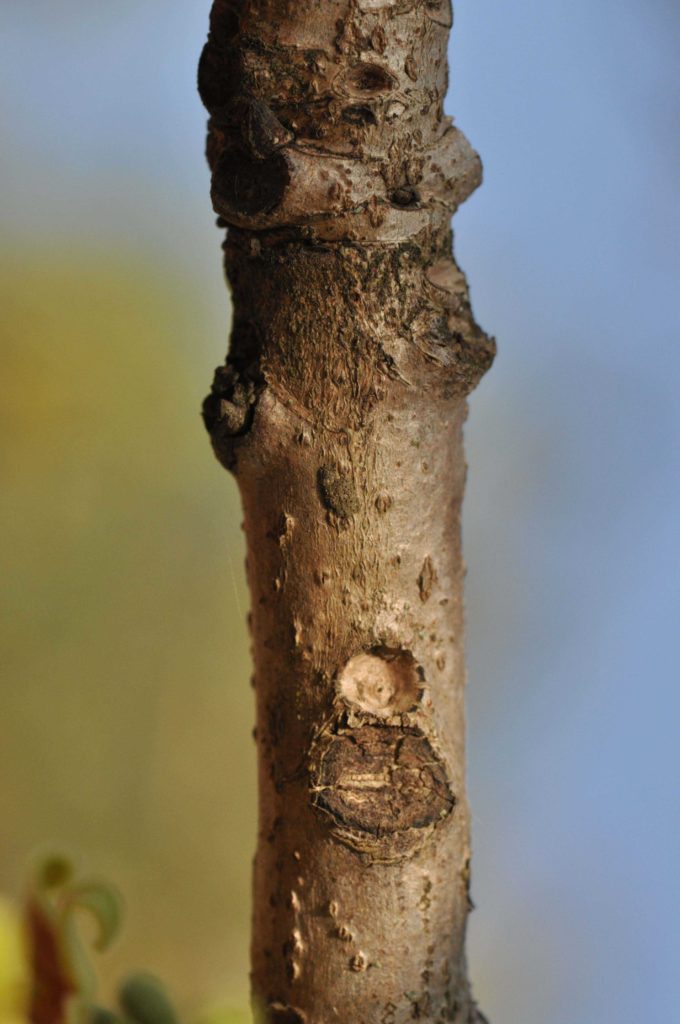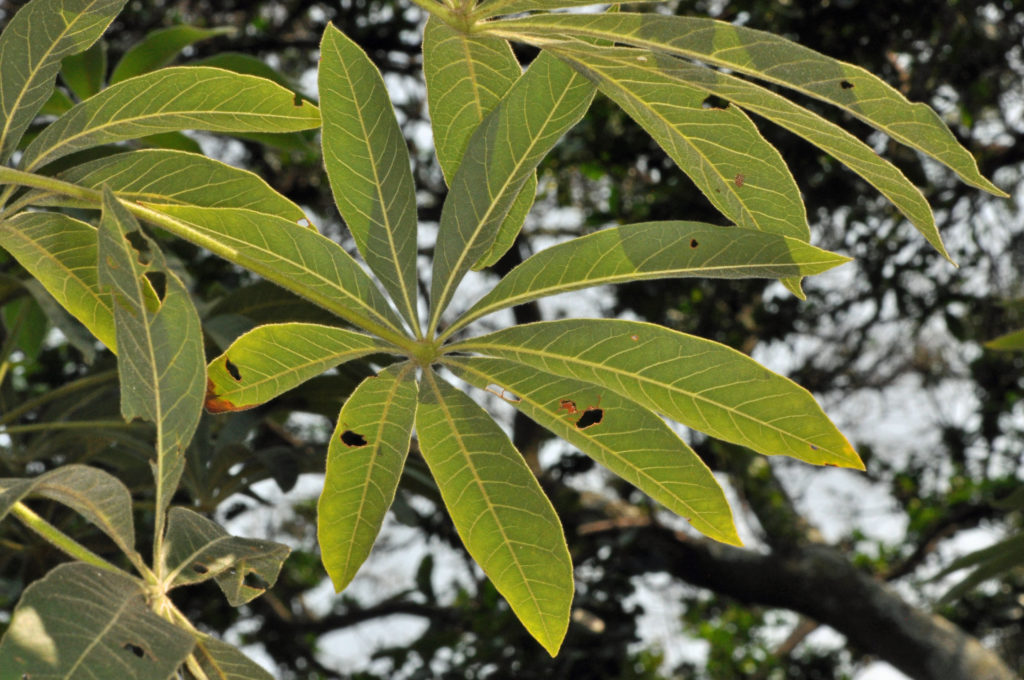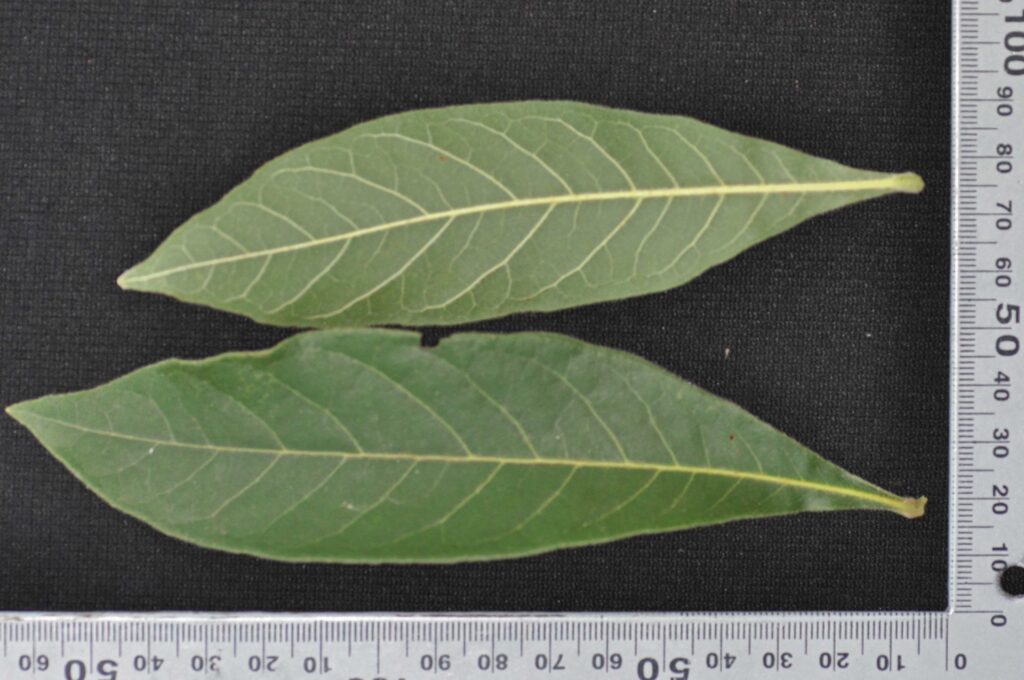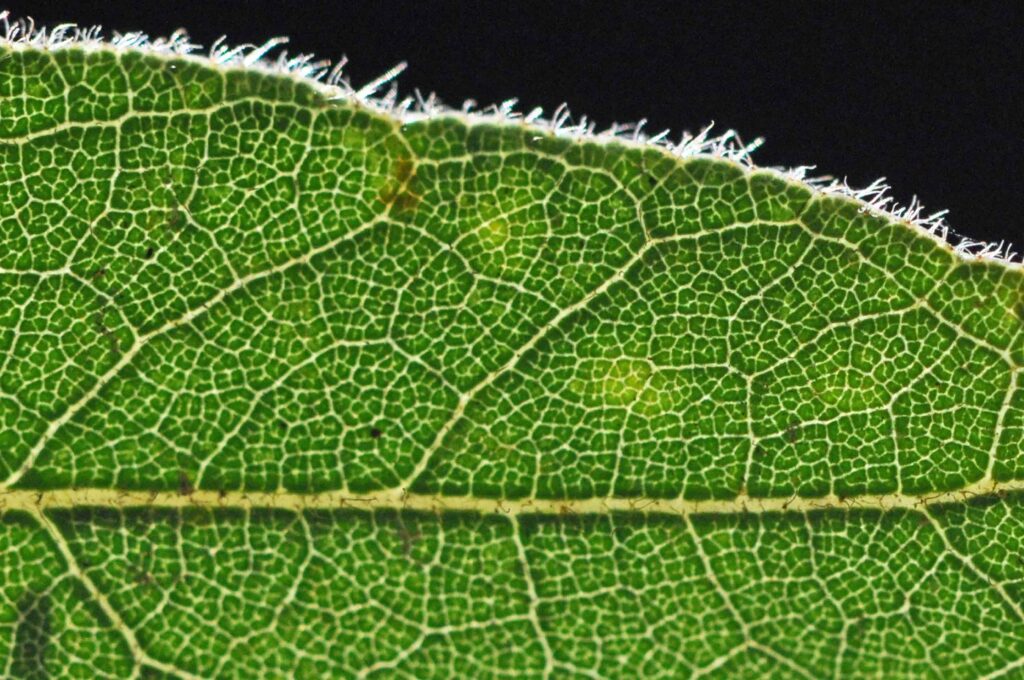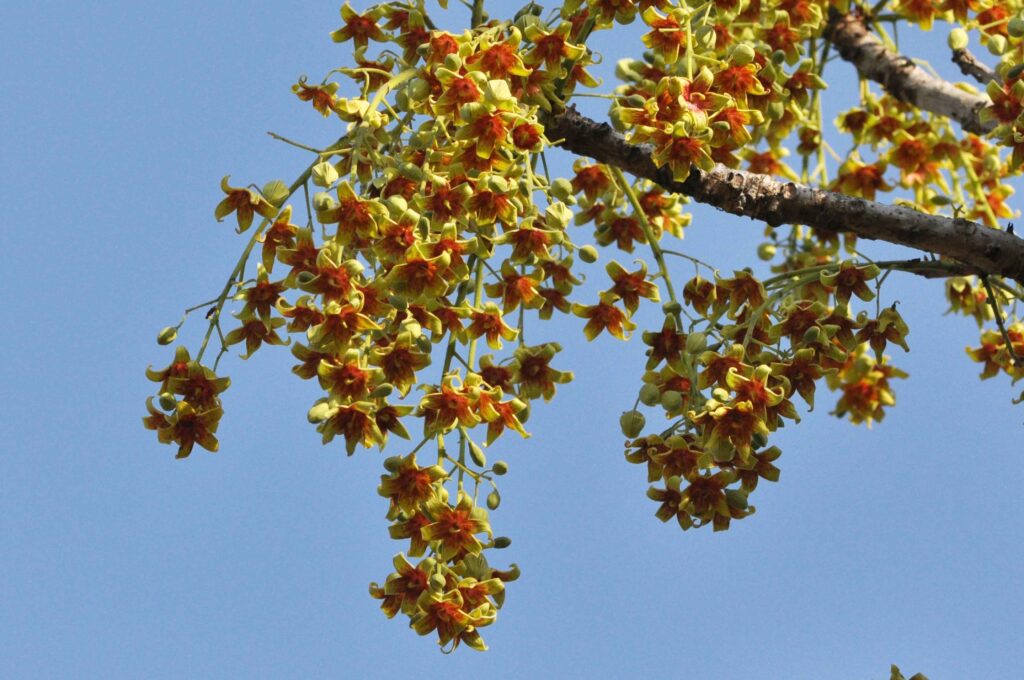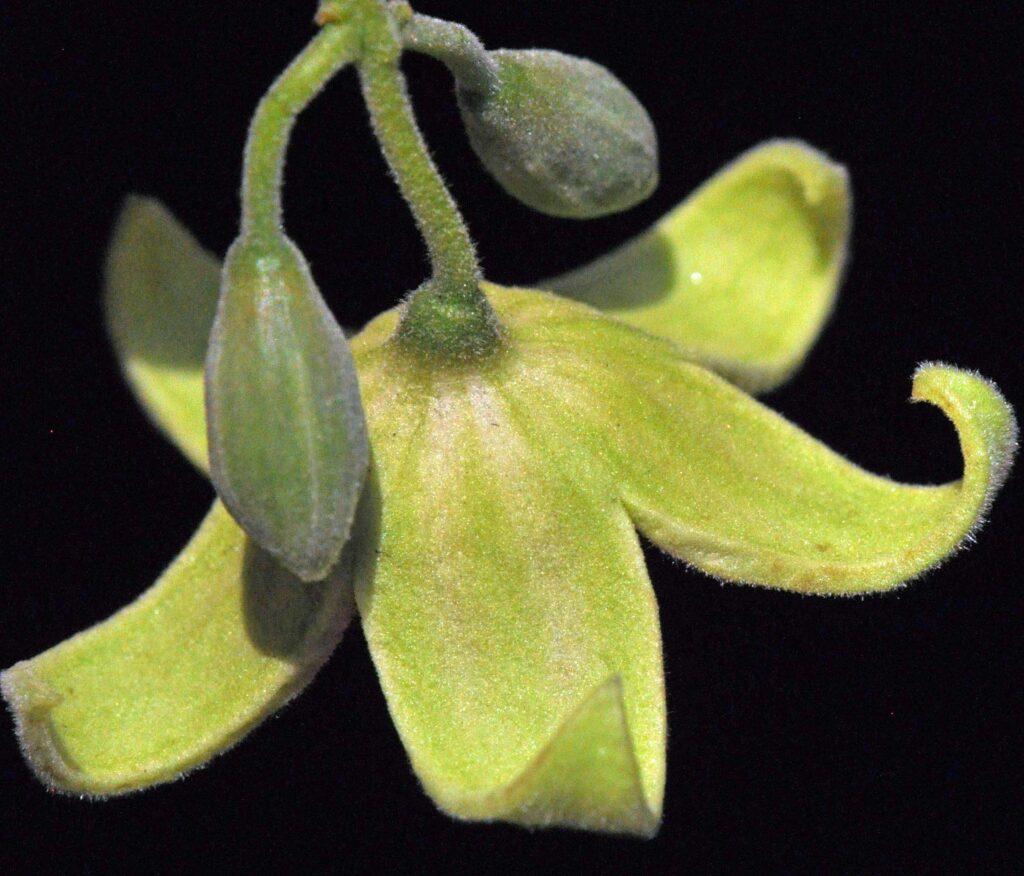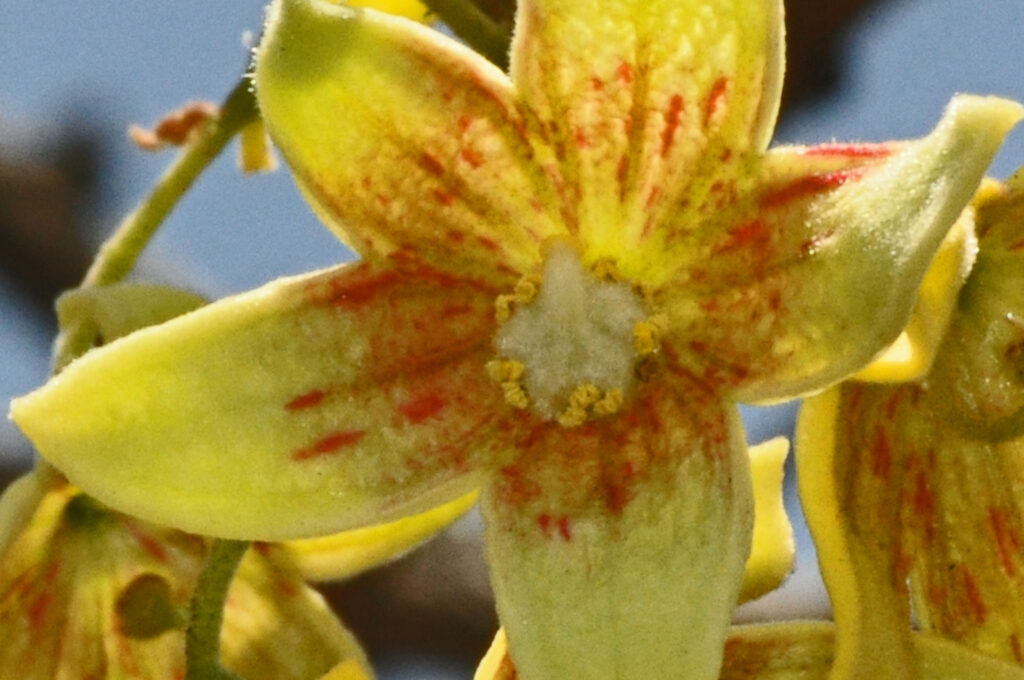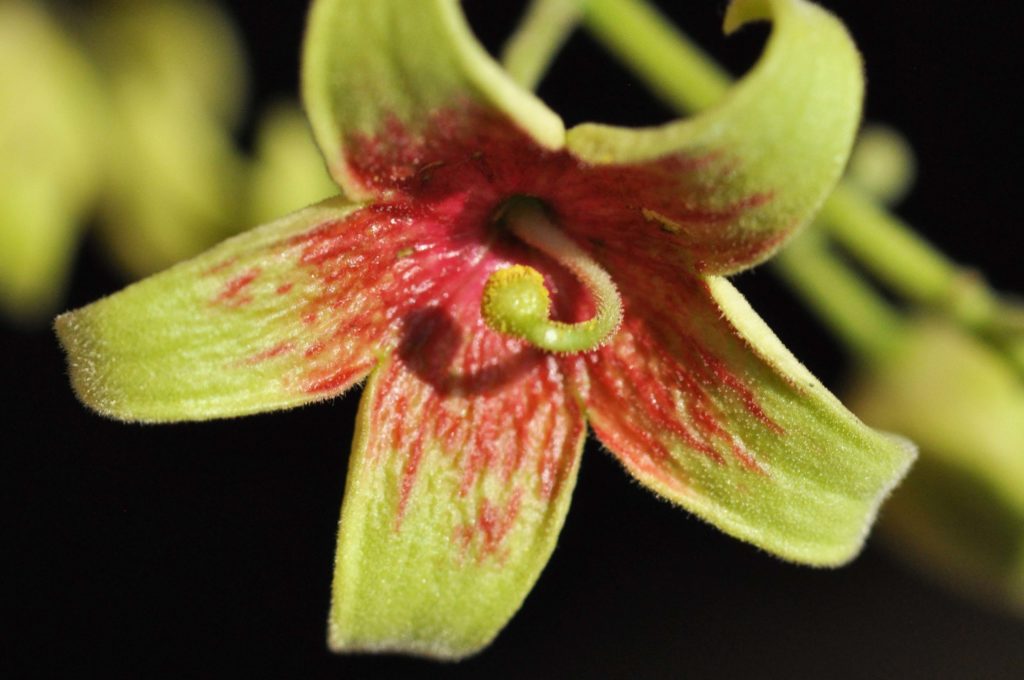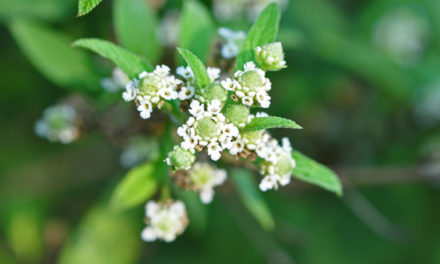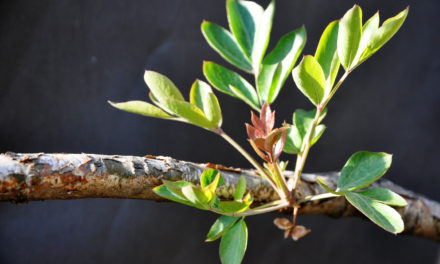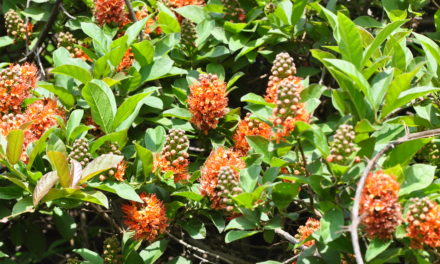General Info – summary
Tree is up to 18m high, has a rounded canopy. Rough bark is in segments or vertically fissured. Palmately compound Leaves have up to 9 hairy leaflets. Stipules and petiolules are absent. The unisexual Flowers are in panicles and lack petals. The petaloid calyx has distinctive red streaks. The superior ovary has a question-mark style ending in a swollen stigma. Spiny large Fruit has large follicles + black edible seeds.
Description
Sterculia murex
SA Tree No. 475.
Common names: (Afr) Laeveldkastaiing, Laeveldsterkastaiing. (Eng) Lowveld Star-chestnut, Lowveld Chestnut. (siSwati) Gebeleweni, Umbhaba. (Xitsonga) Mbava. This tree is not related to the true chestnut, which is in the genus Castanea.
Family: Malvaceae. (Wild Pear, Gossypium – cotton, baobab and Hibiscus family). This family has 240+ genera and 4 200+ species. Most species are herbaceous, but a few are trees. Indigenous genera that have trees on this website includes Adansonia (baobab), Cola, Dombeya, Grewia, Hibiscus, Sparrmannia and Sterculia. Stems contain mucous canals. The usually alternate, often compound or palmately veined Leaves of all possess stipules and apart from Adansonia, remain simple. Flowers are regular, bisexual or unisexual and have 5 petals (Sparrmannia africana has 4) with regularly arranged overlapping edges. Petals are absent in Cola and Sterculia. There are 5 to many stamens with filaments often united into a staminal tube. This surrounds the superior Ovary with axile placentation and its simple Style and capitate or lobed Stigma. Fruits are usually nuts, schizocarps or loculicidal capsules.
Name derivation: Sterculia – named after Sterculius – the Roman god of odour. Some species emit a smell (not this one). There are 5 species of the genus Sterculia in southern Africa. murex – having rough points –like a mollusc with spiky shell – referring to the spiny protuberances on the seed containing follicules.
Conservation: National Status: L C (least concern). Assessed: 2005 (W. Foden and L. Potter).
Tree
When mature, this initially slender Tree (photo 326) can reach up to 18m high (usually less) and form a rounded well-foliated canopy. It may have 1 or 2 stems (stem: main axis of the plant, the leaf and flower bearing as distinguished from the root-bearing axis), each up to 30cm in diameter. The thick, young, reddish-brown Branches (Photo 314) have white hairs. Here Lenticels (a usually raised corky oval or elongated area on the plant that allows the uncontrolled interchange of gases with the environment) are present (Photo 314). Leaf scars are also visible. The grey to black Bark is rough and vertically fissured (photo 313) or cracked into rectangular segments (photo 840).
- 326 2019/08/14 Pretoriuskop KNP. Photo: David Becking.
- 313 2019/08/14 Pretoriuskop KNP. Photo: David Becking.
- 840 2014/09/15 Lowveld NBG. Photo: David Becking.
- 314 2019/08/14 Pretoriuskop KNP. Photo: David Becking.
Leaves
This tree is usually deciduous. The initially soft, dark green alternate Leaves develop towards branch ends. They become hard and palmately compound – (leaflets originating from a single point like the fingers on a hand – photo 911). There are between 5 and 9 Leaflets (photo 911) present. Each leaflet is elliptic, oblong to lanceolate and up to 19 x 5cm – usually smaller. In spring, the young leaves are an attractive bronze colour. The Blade is dark green and hairy on both sides but hairier below where the veins and midrib are also more conspicuous (photo 912). The Vein details are distinctly visible when the leaflet is examined against a strong light – with the aid of a hand lens (photo 316). Here the margin is visible, and the lateral veins emerge at quite an angle and join close to the margin. Both the Apex and Base taper narrowly. The long, hairy Margin is entire (smooth around the edge – photo 911). The hairy Petiole (leaf stalk) is long and may reach from 11 to 23cm. Petiolules (stalks of leaflets – photo 912) and Stipules (basal appendages of petiole) are absent.
- 911 2017./03/01 Pretoria NBG. Photo: David Becking.
- 912 2017/03/01 Pretoria NBG. Photo: David Becking.
- 316 2019/08/16 Pretoriuskop KNP. Photo: David Becking. + Sun.
Flowers
The waxy Flowers develop either with or before (usually) the new leaves and are in up to 10cm long Panicles (indeterminate, branched inflorescence with stalked flowers – photo 308). The green buds are elliptic (photo 312) and occur near the ends of branches in long axillary (growing between stem and leaf) sprays. Each flower is up to 3cm in diameter and hangs from a hairy Pedicel (stalk of a single flower – photo 312). The flowers are functionally unisexual (male or female – not both). The open flowers are saucer-shaped and have a diameter of slightly less than 3cm. The hairy Calyx lobes become petaloid (only resembling petals) and these 5 now yellow Sepals lobes have a cone-shaped base from which the hairy lanceolate lobes protrude and become reflexed (photo 312). The inside of the lobes have distinctive red streaks that radiate outwards (photo 310). Petals are absent.
In each Male Flower (photo 841), there is a central terminal Cupule (shaped like a small, inverted cup or dome shaped cap). From the rim of this cupule extends a staminal tube that gives rise to many Stamens with short Filaments. The bilocular Anthers have 2 Thecae (pollen sacs) with longitudinal extrorse (the opposite of introrse i.e. turned outwards) dehiscence. In male flowers, the ovary is rudimentary (photo 841). In the Female Flower (photo 310), there is a single Pistil (a unit of the Gynoecium, the female element of the flower, composed of the Ovary, Style and Stigma). Here the superior Ovary has 4-5 united Carpels (foliar units of a compound pistil or ovary). The Style is hairy and distinctive – curling round like a question mark and ending in a swollen Stigma (the part of the pistil that receives the pollen – photo 310). (Jul-Nov).
- 308 2019/08/16 Pretoriuskop KNP. Photo: David Becking
- 312 2019/08/16 Pretoriuskop KNP. Photo: David Becking.
- 841 2014/09/16 Lowveld NBG. Photo: David Becking.
- 310 2019/08/16 Pretoriuskop KNP. Photo: David Becking.
Fruit
The star-shaped Fruit is up to 30cm in diameter and has 3-5 hairy, dehiscent Follicles (dry dehiscent fruits that open only on the front side and are the product of a single pistil) that are joined at the base. These follicles arise from an ovary with the same number of lobes. They enlarge into distinct woody, boat-shaped structures up to 20 x 13cm that are covered by thick, hard and blunt spines (hence, the species name murex). The combined fruit can reach more than 25cm in diameter and are usually situated high in the tree. The green to yellow follicles turn brown when mature and split along the upper surface – revealing about 10 black, smooth Seeds (each about 3 x 2,5cm) surrounded by irritating hairs. Each seed is about 30 x 2,5cm and has a small Aril (an appendage or outer covering of a seed that may appear as a pulpy covering. It develops from a stalk, the funiculus, connecting an ovule or a seed with the placenta and not from the micropyle of the ovule). (Oct-Feb).
Distribution & Ecology
These Trees grow in wooded, rocky ridges, koppies (small, often slightly isolated, natural hills rising up from the flattish African veld) and deep sandy or loamy soils in the bushveld (a sub-tropical woodland ecoregion of southern Africa) – often with a low pH (acidic) value. This plant is Endemic (restricted to a particular geographic location) in southern Africa. It is found in Northern Gauteng, Limpopo and Mpumalanga – e.g. in the hills near Pretorius Kop in the KNP and in Eswatini (Swaziland). Baboons and monkeys feed on the oily Seeds. People enjoy eating the seeds after roasting.
Ethnobotany
The fruit Hairs are irritating. However, the Seeds have a high oil content, are edible and especially tasty – when fried over coals. The seeds grow quickly and are suitable for planting. The plants grow relatively quickly but are frost sensitive. Ashtrays are made from fruit Shells. Cotton-stainer nymphs (Dysdercus suturellus – red bug), in the family Pyrrhocoridae, feed on the leaves and on cotton balls changing the cotton to an indelible brownish yellow. As a result, these trees are not popular with cotton farmers. These red bugs are preyed upon by cotton-stainer assassin bugs (Phonoctonus sp). The Wood is soft and of little use. The empty fruiting carpels are occasionally used as ashtrays.
References
Boon, R. 2010. Pooley’s Trees of eastern South Africa. Flora and Fauna Publications Trust, Durban.
Coates Palgrave, M. 2002. Keith Coates Palgrave Trees of Southern Africa, edn 3. Struik, Cape Town.
Foden, W. & Potter, L. 2005. Sterculia murex Hemsl. National Assessment: Red List of South African Plants version 2020.1. Accessed on 2024/01/22.
Lawrence, G. H. M, 1951. Taxonomy of Vascular Plants. The Macmillan Company, New York. Tenth Printing 1965.
Palmer, E. & Pitman, N. 1972. Trees of southern Africa. Balkema, Amsterdam, Cape Town.
Schmidt, S. Lotter, M. & McCleland, W. 2002. Trees and Shrubs of Mpumalanga and the Kruger National Park. Jacana, Johannesburg.
van Wyk, B. & van Wyk, P. 1997 Field guide to Trees of Southern Africa. Struik, Cape Town.
http://www.plantzafrica.com/plantqrs/sterculmurex.htm
https://en.wikipedia.org/wiki/Sterculia_murex
http://posa.sanbi.org/flora/browse.php?src=SP
https://www.farmersweekly.co.za/farm-basics/how-to-crop/know-your-crop-pests-cotton-stainer/
cotton stainer – Dysdercus suturellus (Herrich-Schaeffer) (ufl.edu)
https://en.wikipedia.org/wiki/Sterquilinus

